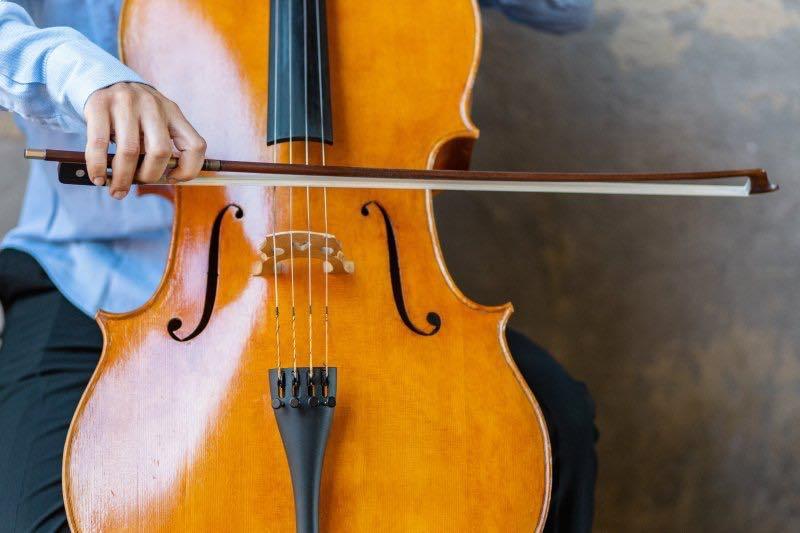The two lowest members of the string section are the cello and bass. If you look at these two instruments – cello vs. bass – side by side, you may think they look similar. And yet, they are actually very different.
So, What’s the Difference Between the Cello Vs. Bass?
If you go way back in history to the origins of string instruments, you’ll find that the cello and the bass aren’t even from the same family. Taking a closer look at both instruments, you will see that their bodies are unique, and they have a unique set of characteristics. Once you are aware of them, they will be easily distinguishable.
Cello and bass typically function in a similar fashion in orchestras, but their sounds complement each other because of their differences.
Way back in the beginning of time (well, string instrument time!) in the sixteenth century, our friends, the violin and the bass were being meticulously crafted by some of the finest craftspeople on the planet. These craftspeople were called luthiers.
Luthiers knew that cellos and basses were so different, that they weren’t even like siblings. They were more like cousins. Cellos are directly related to violins and violas, while the bass has a whole unique set of characteristics.
Here are a few key characteristics of each that will help you determine: is it a cello or a bass?
Cello Vs. Bass: A Point-By-Point Comparison
Let’s take a look at some key differences between cello and bass.
First of All, the Size
A full-size bass is quite large; I’m talking taller than the average man. Full-size basses are about 6’5” or 75”. This typically means that the bassist must stand or use a stool to play the instrument. Cello on the other hand at its largest is about 5’ or 60” and the performer will be seated on an average sized chair.
Tuning Pegs & Scrolls
If you look to the top of these instruments, you’ll see a rolled wooden area called scroll. Here, you’ll notice a few more distinguishing characteristics. Cellos have little things sticking out of the side, which are called pegs, and bass has knobs that usually point towards the back of the scroll, which are called tuning machines.
If you look closely at both instruments, you will also notice a variety of physical differences. The bass tends to have more variants in structure than cello, like more sloping shoulders.
And Getting Even More Technical…
Let’s get even more technical in our cello vs. bass comparison, before we get to the fun stuff.
Cello and bass are both low instruments. However, the bass is about an octave lower than cello. Unlike its cousins, the contrabass’ strings are in fourths. The strings on a bass are – from low to high – E A D G.
In case you need a little help remembering the strings, just think Elephants Always Do Good.
In contrast, a cello is strung like its higher siblings, violin and viola. The cello is strung in fifths: C G D A.
The bass’s strings sound the lowest notes on the piano reaching all the way to the lowest E, and sometimes C on the piano. Those notes are so low that you can almost count the number of vibrations per second. Cello is about an octave higher than the bass.
Think of a person in your life that has a low voice as being a cello. Then, imagine you meet someone whose voice is an octave lower. Yikes! That person would sound more like a bass. Cello also has a wider range, not to brag – but it’s pretty impressive.
Of Course, the Sound!
Really, if you are interested in either of these instruments, you came here for the SOUND! There is nothing better than the sound from a big cello and bass section working together to create a foundation for the rest of an orchestra to build upon. Basses truly are the foundation of a musical group.
The tone is so full; it reminds me of dragging my hand across a suede jacket or the inside of my case that has velvet. A sound that is soft but just enough resistance that feels so good. If you don’t know what I’m talking about, go and listen to the fourth movement of Beethoven’s 9th symphony. The cellos and bass are a divine sound, or maybe this is the sound of Beethoven’s own voice being personified in this beautiful interaction between the cello and bass and the rest of the orchestra.
Personal Preference
Here comes a bit of personal preference. I am a cellist and cello has a sound that is so human. The normal speaking voice and singing range of a choir sits within the cello’s range; from that low C all the way to some of the higher notes on the A string.
Everything you ever need to know about the cello’s sound can be personified in Saint-Saen’s The Swan and Elgar’s Cello concerto. Listen to those two pieces, and I guarantee you will fall in love with the heavenly sonority that this instrument produces.
When wondering about cello vs. bass, remember that these two instruments are strikingly different, with sounds that beautifully compliment one another. The bass’s thick, luxurious sound so perfectly gives the cello’s sweet, pure sound more weight. Together, they produce the foundation of an orchestra.
Braxton Alexander Porter

